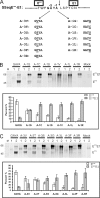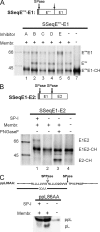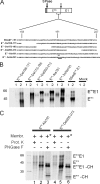A new type of signal peptidase cleavage site identified in an RNA virus polyprotein
- PMID: 20093364
- PMCID: PMC2838279
- DOI: 10.1074/jbc.M109.083394
A new type of signal peptidase cleavage site identified in an RNA virus polyprotein
Abstract
Pestiviruses, a group of enveloped positive strand RNA viruses belonging to the family Flaviviridae, express their genes via a polyprotein that is subsequently processed by proteases. The structural protein region contains typical signal peptidase cleavage sites. Only the site at the C terminus of the glycoprotein E(rns) is different because it does not contain a hydrophobic transmembrane region but an amphipathic helix functioning as the E(rns) membrane anchor. Despite the absence of a hydrophobic region, the site between the C terminus of E(rns) and E1, the protein located downstream in the polyprotein, is cleaved by signal peptidase, as demonstrated by mutagenesis and inhibitor studies. Thus, E(rns)E1 is processed at a novel type of signal peptidase cleavage site showing a different membrane topology. Prevention of glycosylation or introduction of mutations into the C-terminal region of E(rns) severely impairs processing, presumably by preventing proper membrane interaction or disturbing a conformation critical for the protein to be accepted as a substrate by signal peptidase.
Figures








Similar articles
-
Downstream Sequences Control the Processing of the Pestivirus Erns-E1 Precursor.J Virol. 2020 Dec 9;95(1):e01905-20. doi: 10.1128/JVI.01905-20. Print 2020 Dec 9. J Virol. 2020. PMID: 33028718 Free PMC article.
-
Characterization of Membrane Topology and Retention Signal of Pestiviral Glycoprotein E1.J Virol. 2021 Jul 12;95(15):e0052121. doi: 10.1128/JVI.00521-21. Epub 2021 Jul 12. J Virol. 2021. PMID: 34011544 Free PMC article.
-
Charged Residues in the Membrane Anchor of the Pestiviral Erns Protein Are Important for Processing and Secretion of Erns and Recovery of Infectious Viruses.Viruses. 2021 Mar 10;13(3):444. doi: 10.3390/v13030444. Viruses. 2021. PMID: 33801849 Free PMC article.
-
Delayed by Design: Role of Suboptimal Signal Peptidase Processing of Viral Structural Protein Precursors in Flaviviridae Virus Assembly.Viruses. 2020 Sep 26;12(10):1090. doi: 10.3390/v12101090. Viruses. 2020. PMID: 32993149 Free PMC article. Review.
-
Viral precursor polyproteins: keys of regulation from replication to maturation.Curr Opin Virol. 2013 Apr;3(2):137-42. doi: 10.1016/j.coviro.2013.03.009. Epub 2013 Apr 18. Curr Opin Virol. 2013. PMID: 23602469 Free PMC article. Review.
Cited by
-
Classical swine fever in India: current status and future perspective.Trop Anim Health Prod. 2018 Aug;50(6):1181-1191. doi: 10.1007/s11250-018-1608-5. Epub 2018 May 4. Trop Anim Health Prod. 2018. PMID: 29725815 Review.
-
Structure of the membrane anchor of pestivirus glycoprotein E(rns), a long tilted amphipathic helix.PLoS Pathog. 2014 Feb 27;10(2):e1003973. doi: 10.1371/journal.ppat.1003973. eCollection 2014 Feb. PLoS Pathog. 2014. PMID: 24586172 Free PMC article.
-
Characterization of the Determinants of NS2-3-Independent Virion Morphogenesis of Pestiviruses.J Virol. 2015 Nov;89(22):11668-80. doi: 10.1128/JVI.01646-15. Epub 2015 Sep 9. J Virol. 2015. PMID: 26355097 Free PMC article.
-
The Molecular Basis for Erns Dimerization in Classical Swine Fever Virus.Viruses. 2021 Nov 2;13(11):2204. doi: 10.3390/v13112204. Viruses. 2021. PMID: 34835010 Free PMC article.
-
Fifty Shades of Erns: Innate Immune Evasion by the Viral Endonucleases of All Pestivirus Species.Viruses. 2022 Jan 27;14(2):265. doi: 10.3390/v14020265. Viruses. 2022. PMID: 35215858 Free PMC article.
References
-
- Heinz F. X., Collett M. S., Purcell R. H., Gould E. A., Howard C. R., Houghton M., Moormann J. M., Rice C. M., Thiel H. J. (2000) in Virus Taxonomy: Seventh Report of the International Committee on Taxonomy of Viruses (van Regenmortel M. H. V., Fauquet C. M., Bishop D. H. L., Carstens E. B., Estes M. K., Lemon S. M., Maniloff J., Mayo M. A., McGeoch D. J., Pringle C. R., Wickner R. B. eds) pp. 859–878, Academic Press, Inc., San Diego, CA
-
- Lindenbach B. D., Thiel H.-J., Rice C. M. (2007) in Fields Virology (Knipe D. M., Howley P. M. eds) pp. 1101–1152, Lippincott-Raven Publishers, Philadelphia
-
- Collett M. S., Larson R., Belzer S. K., Retzel E. (1988) Virology 165, 200–208 - PubMed
-
- Collett M. S., Moennig V., Horzinek M. C. (1989) J. Gen. Virol. 70, 253–266 - PubMed
Publication types
MeSH terms
Substances
LinkOut - more resources
Full Text Sources

